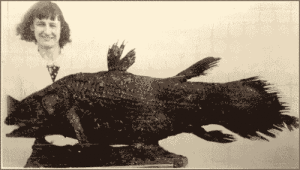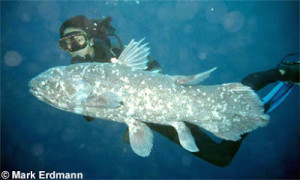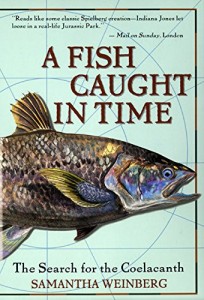Off The Bookshelf: A Fish Caught in Time – The Search for the Coelacanth
How about a new book recommendation for this year’s reading list? This one’s a little different from my other Off The Bookshelf entries as it’s actually a nonfiction tale, and a marine biology-themed one at that! I read this book last year for school, and I was so enraptured by this incredible true “scientific epic” that I had to share it on my blog.
So if you’ve never heard of the coelacanth, or you have but want to learn the details of its history, you’re in for a treat! I hope you’ll enjoy my review of this must-read book: A Fish Caught in Time: The Search for the Coelacanth by Samantha Weinberg.
Summary
A Fish Caught in Time tells the true story of the coelacanth (SEE-luh-kanth), one of the most mysterious and fascinating fishes (yes, “fishes“) in scientific history, as written by English journalist Samantha Weinberg. Originally published in 1999 by HarperCollins, the book recounts the events surrounding this prehistoric fish, from the shocking discovery of a living specimen (Latimeria chalumnae) in 1938 to the discovery and study of a second species (Latimeria menadoensis) 60 years later. The narrative relates these events from the perspective of the researchers who dedicated much of their time and resources to studying this fish, all of whom played an important role in the amazing story of the elusive “King of the Sea”.
Review
I read this book last year in preparation for a Vertebrate Zoology class I had to help teach as part of my Master’s program. My lesson was about the Sarcopterygii class of fishes, so my professor lent me his copy of A Fish Caught in Time as supplementary material for telling the story of the coelacanth. By the time I was done, I was ready to teach an entire semester on this one fish. I never thought I would feel so strongly about any one fish, but then again, the coelacanth is no ordinary fish.

Marjorie Courtenay-Latimer with the modern coelacanth (Latimeria chalumnae) she discovered in 1938
To summarize, the coelacanth was long thought lost to history by the Cretaceous-Paleogene extinction event that wiped out three quarters of the plant and animal species living on Earth (most famously the dinosaurs). It was known only by its fossil record for (almost exactly) 100 years, until, to the world’s surprise and excitement, a living specimen was fished off the South African coast in 1938. Over the next six decades, the coelacanth would be the focus of global headlines, political plays, and scientific rivalries, all the while remaining an enigma to the world that it continues to captivate to this day.
A rare example of a nonfiction story told in a highly narrative form, A Fish Caught in Time does an excellent job of capturing the majesty and mystery of the coelacanth while staying true to the history of its discovery and study. Ms. Weinberg paints such a vivid picture of this 60-year-long story that I couldn’t help but be completely drawn in, as if I were living the story along with the real-life characters: the excitement of discovering the coelacanth wasn’t extinct after all, the rush to find out where it had been hiding for the past 65 million years, the desperation to not only capture a living specimen but keep it alive at the surface, the awe that only a lucky few in history have ever known of watching this deep-sea fish swim in its natural habitat. I’d even go as far as to say that it’s impossible to read this book and not fall in love with the coelacanth!

Arnaz Erdmann swimming with the Indonesian coelacanth (Latimeria menadoensis)
A fair note of warning: oftentimes the story focuses more on the researchers who dedicated their lives to studying the coelacanth than on the coelacanth itself. Readers who hope to gain an insight exclusively into the life of the fish may find this a bit off-putting, but then again, it hardly makes sense to attempt to recount the history around the animal without offering even a glimpse into the lives of the people who shaped that history. It’s much more than a story about a fish; it’s a lesson about what it means to be a researcher. It takes intelligence, curiosity, patience, an unquenchable thirst for knowledge, and an unrelenting passion for science, all of which shine through the pages of this brilliant narration of scientific truth.
Overall, A Fish Caught in Time is a captivating read that any science enthusiast will enjoy. I owe much of my appreciation for the coelacanth to this book, and I recommend it to anyone who wants to immerse themselves in a world of marine biology without being overwhelmed by the technicalities of it all. As quickly becomes evident from the first chapter, science doesn’t have to be fictional to blend well with creative writing!
Inspiration
I love science and I love a good story, but it’s rare that I get to enjoy both at the same time, or at least in the same book. A Fish Caught in Time offers an opportunity to glimpse the joy and passion that goes into conducting good science by presenting it in an enjoyable narrative format. Though much research has gone into understanding the coelacanth, A Fish Caught in Time never conveys that research in a manner too difficult for the layman to comprehend or appreciate, making it an unusual kind of literary gem: a scientific subject made accessible to the general public, that is, a community of non-scientific readers.
So if you appreciate science and a good story based on true events, A Fish Caught in Time may be just the inspiration you need for your creative writing! It certainly has been for me; in my opinion, there’s never too much writing inspiration to be found in science!



Recent Comments